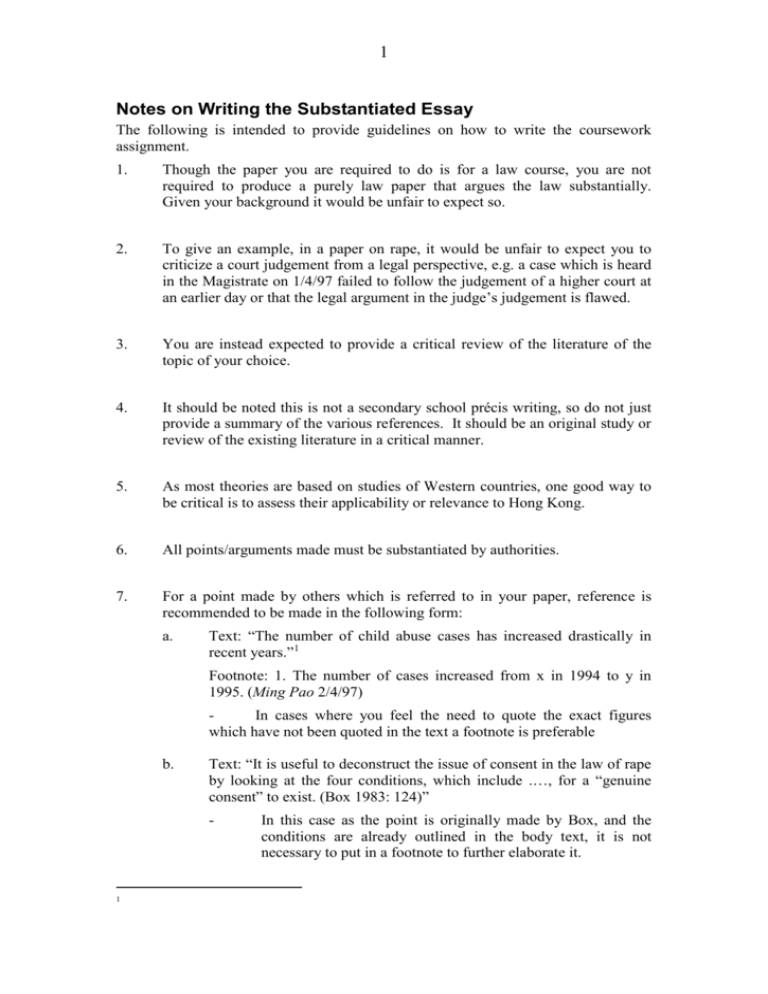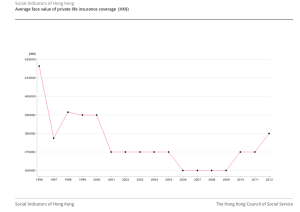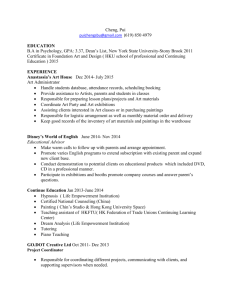How to write your essay?
advertisement

1 Notes on Writing the Substantiated Essay The following is intended to provide guidelines on how to write the coursework assignment. 1. Though the paper you are required to do is for a law course, you are not required to produce a purely law paper that argues the law substantially. Given your background it would be unfair to expect so. 2. To give an example, in a paper on rape, it would be unfair to expect you to criticize a court judgement from a legal perspective, e.g. a case which is heard in the Magistrate on 1/4/97 failed to follow the judgement of a higher court at an earlier day or that the legal argument in the judge’s judgement is flawed. 3. You are instead expected to provide a critical review of the literature of the topic of your choice. 4. It should be noted this is not a secondary school précis writing, so do not just provide a summary of the various references. It should be an original study or review of the existing literature in a critical manner. 5. As most theories are based on studies of Western countries, one good way to be critical is to assess their applicability or relevance to Hong Kong. 6. All points/arguments made must be substantiated by authorities. 7. For a point made by others which is referred to in your paper, reference is recommended to be made in the following form: a. Text: “The number of child abuse cases has increased drastically in recent years.”1 Footnote: 1. The number of cases increased from x in 1994 to y in 1995. (Ming Pao 2/4/97) In cases where you feel the need to quote the exact figures which have not been quoted in the text a footnote is preferable b. Text: “It is useful to deconstruct the issue of consent in the law of rape by looking at the four conditions, which include .…, for a “genuine consent” to exist. (Box 1983: 124)” - 1 In this case as the point is originally made by Box, and the conditions are already outlined in the body text, it is not necessary to put in a footnote to further elaborate it. 2 8. For an original point made by yourself, you must elaborate it substantially. For Example: Point you want to make: The law of rape in Hong Kong is sexually biased in that women could not be guilty of raping men. As this is an original point, which has not been made by others, you would need to make substantial arguments to support yourself. First quote s.118 of the Crimes Ordinance, especially the relevant wording which support your argument should be highlighted. Then elaborate by referring to the sections and other references why you think this is a form of sex bias. Such references may include laws of other countries which also criminalize rape of men by women and articles from medical journals showing that men’s penis may be in a state capable of entering women’s vagina without the men’s consent or consciousness. 9. If you follow the mode of citation I suggest (i.e. (“name of the author” “year of publication”: “page on which the point is made”, e.g. (Box 1983: 124), then at the end of your paper there should be a list of references which have actually been referred to. Please do not include authorities that you have read but not referred to in the text in this list. References should be arranged in alphabetical order of the authors’ surnames. Examples: i. Book “Surname of the author”, “Other names”. “Year of publication”. “Name of Book”(which should be italicized or underlined). “Place of publication”: “Name of publisher” e.g. ii. Box, Stephen. (1983) Power, Crime and Mystification. London and New York: Tavistock Publications. Chapter in a book. “Surname of the author of the chapter that you refer to”, “Other names of this author”. “Year of Publication”. “Name of chapter”(quotation marks should be used) in “Name of editor of the book” (ed.) “Name of the book”(which should be italicized or underlined) “Place of publication”: “Name of publisher” e.g. iii. Kennedy, Duncan. (1990) “Legal Education as Training for Hierarchy” in David Kairys (ed.). The Politics of Law: A Progressive Critique. New York: Pantheon books. Journal article “Surname of the author of the article that you refer to”, “Other names of this author”. “Year of Publication”. “Name of article”(quotation marks should be used) “Name of the Journal”(which should be italicized or underlined). “Vol. No” “Page No” e.g. Sin, Wai Man and Chu, Yiu Wai. (1998) “Whose Rule of Law? 3 Rethinking (Post-)Colonial Legal Culture in Hong Kong” Social & Legal Studies 7(2): 49-86. iv. Legal case “Name of the Case” (which should be italicized) “Year of publication” “Vol. No” “Abbreviation of the name of the law report” “page number” e.g. v. Statute cited “name of statute” “Chapter No” “Laws of Hong Kong”(which should be italicized) e.g. vi. Beal v Kelly [1951] 2 All ER 763 Crimes Ordinance. Cap.200. Laws of Hong Kong. Newspaper article “Name of newspaper”(which should be italicized). “Date” “name of article”(quotation marks should be used). e.g. South China Morning Post. 23/11/96. “Patten: Why We Need the Rule of Law”. vii. In case the reference you use is in Chinese give the Chinese name of it followed by an English translation. viii. Web: “Name of the source/author/organization”. “Year of Publication”. “Name of page”(quotation marks should be used) “URL”(Date on which it is accessed) e.g. Hong Kong Medical Council (2000) “Professional Code and Conduct: For the Guidance of Registered Medical Practitioners” http://www.mchk.org.hk/draft.htm (accessed on 31 August 2000). 10. You may also discuss amongst yourselves the topic you are doing. But you have to be very careful that the discussion must be limited to an mere exchange of views. No collaborated work is accepted, and anything of such sort would amount to plagiarism, which is a very serious offence. If you feel there is a need to discuss with your colleagues, make sure that points which are illuminated by the discussion must be appropriately acknowledged in the paper. The way to do this is to add a footnote after the point saying something like: “I am thankful to X for bringing this point to my notice” or “ This point was made be Y in a discussion among X, Y, Z and myself”. Failure to make proper acknowledgement amounts to plagiarism. Such points should never compose a substantial part of your essay. It should contribute only to a very small part of it. Less credit will be given for points of this sort. 11. The references given with the suggested topics are the basics. You may wish to consult other references. One good source is the works referred to in the references given by us. Another source is the library’s online database. ProQuest (choose all databases) and Sociological Abstract could provide very 4 useful information on journal and newspaper articles for the topic of your choice. They are also very easy to use. As the number of copies of a book is inevitably limited, it could be quite difficult to get hold of a book. Journal articles therefore provide a valuable source of references. 12. Another good source of references is library books. Our library catalogue also includes contents of the books. So it will be very useful to search by keyword, other than just by subject. For example if you want to do something on the law of rape, a search by subject will only show one book under the subject: rape law and legislation England. But if you search by the keywords: law and rape, it will find you 86 books! So the difference is obvious. Try this out; it’s very useful. 13. My paper on rape (included in the materials on sex crime) should make a good example on how to write your term paper. 14. Have a happy cruise in the sea of books/articles. 15. Good luck! Sin Wai Man 27 October 2001








